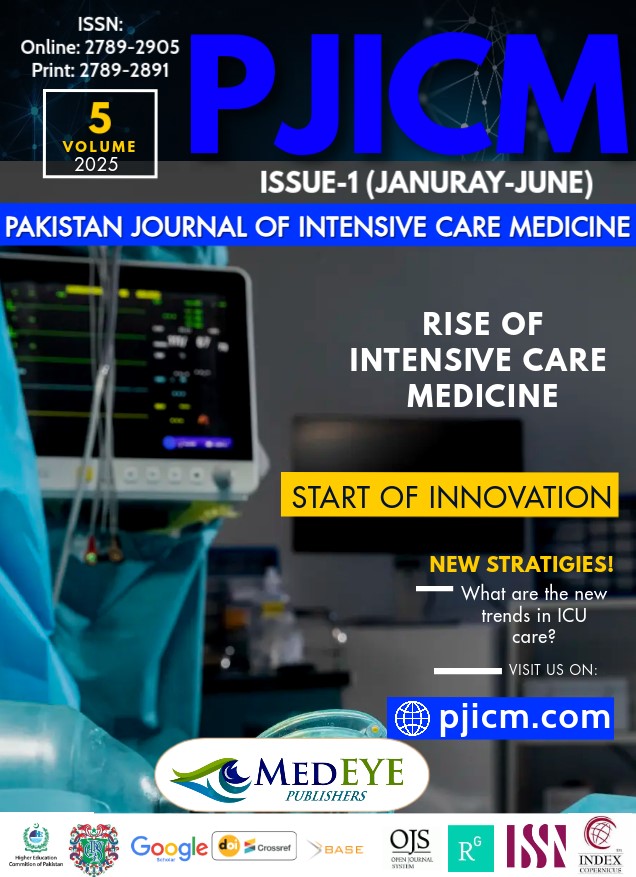INVESTIGATING THE LINK BETWEEN SLEEP APNEA AND CARDIOVASCULAR DISEASE PROGRESSION: A LONGITUDINAL STUDY
DOI:
https://doi.org/10.54112/pjicm.v5i01.56Keywords:
Sleep apnea, Cardiovascular disease, Pakistan, Inflammation, Hypertension, Longitudinal study, hs-CRPAbstract
Background: Obstructive sleep apnea (OSA) is increasingly acknowledged as an independent risk factor for cardiovascular disease (CVD), mainly due to intermittent hypoxia, systemic inflammation, and sympathetic overactivity. Despite its clinical significance, there is a scarcity of longitudinal data from South Asia, particularly Pakistan, assessing CVD progression about OSA severity. Objective: To investigate the relationship between the severity and progression of obstructive sleep apnea (OSA) and cardiovascular disease. Study Design: Prospective longitudinal study. Setting: This study was conducted at a tertiary care hospital in Pakistan. Duration of Study: April 2023 to October 2023, (enrollment), with a 12-month follow-up period for each participant. Methods: A total of 78 adults with newly diagnosed moderate to severe obstructive sleep apnea (Apnea-Hypopnea Index [AHI] ≥15), confirmed through polysomnography, were enrolled. Participants were followed for 12 months, during which cardiovascular parameters—including systolic and diastolic blood pressure, lipid profile, high-sensitivity C-reactive protein (hs-CRP), and cardiovascular events (such as myocardial infarction and angina)—were monitored. Data were analyzed using SPSS version 26. Statistical tests included paired t-tests, chi-square tests, and logistic regression; p-values less than 0.05 were considered statistically significant. Results: Over the 12-month follow-up, there were statistically significant increases in: Systolic blood pressure (mean +6.7 mmHg, p = 0.01), Diastolic blood pressure (mean +4.2 mmHg, p = 0.03), LDL cholesterol levels (p = 0.04), hs-CRP levels (p < 0.01), Cardiovascular events occurred more frequently in the severe OSA group (8 events) than in the moderate OSA group (3 events). Severe OSA and elevated hs-CRP levels (≥5 mg/L) were identified as independent predictors of cardiovascular events with odds ratios (OR) of 3.8 and 4.1, respectively. Conclusion: Severe obstructive sleep apnea significantly contributes to cardiovascular disease progression in the Pakistani population, likely mediated through inflammatory and hypertensive mechanisms. Early detection and management of OSA may offer a strategic opportunity to mitigate long-term cardiovascular risks.
References
Fava C, Dorigoni S, Dalle Vedove F, et al. Sleep apnea and cardiovascular risk: A comprehensive review. J Clin Med. 2020;9(12):3981.
Khan A, Shamsi T, Fatima N, et al. Risk for sleep apnea among Pakistani adults using the Berlin Questionnaire. Sleep Health. 2020;6(2):204–210.
Rafique G, Khuwaja A, Azam I, et al. Prevalence of undiagnosed hypertension and associated factors in urban Pakistan. BMC Public Health. 2019;19(1):694.
Shah N, Ali S, Anwar F, et al. Prevalence of obstructive sleep apnea in patients with ischemic heart disease. J Pak Med Assoc. 2022;72(8):1576–1580.
Basit A, Fawwad A, Siddiqui SA, et al. Prevalence of overweight and obesity in Pakistan: A population-based analysis. Diabetes Metab Syndr Obes. 2020;13:1185–1194.
Jafar TH, Haque WU, Islam M, et al. The rise of diabetes and cardiovascular disease in Pakistan: The urgent need for preventive policies. Lancet Reg Health Southeast Asia. 2022;2:100015.
Dempsey JA, Veasey SC, Morgan BJ, O’Donnell CP. Pathophysiology of sleep apnea and its cardiovascular implications. Physiol Rev. 2021;101(4):1327–1403.
Tanriverdi H, Evrengul H, Kara CO, et al. High-sensitivity C-reactive protein and cardiovascular risk in OSA patients. Sleep Breath. 2021;25(1):275–281.
Ahmed A, Usman H, Sohail S, et al. Association of obstructive sleep apnea with uncontrolled hypertension in patients presenting to tertiary care. Cureus. 2021;13(6):e15820.
Waheed S, Imtiaz T, Munir A. Obstructive sleep apnea in ischemic heart disease: An under-recognized comorbidity. Pak Heart J. 2023;56(1):22–26.
Yaggi HK, Concato J, Kernan WN, Lichtman JH, Brass LM, Mohsenin V. Obstructive sleep apnea as a risk factor for stroke and death. N Engl J Med. 2005;353(19):2034–41.
Shah NA, Yousuf M, Ghani F, et al. Impact of obstructive sleep apnea severity on progression of coronary artery disease: A longitudinal study. Pak Heart J. 2021;54(3):145–50.
Jelic S, Padeletti M, Kawut SM, et al. Inflammation, oxidative stress, and repair capacity of the vascular endothelium in obstructive sleep apnea. Circulation. 2019;119(2):237–46.
Mehra R, Patel SR, Jeon S, et al. Association of nocturnal hypoxemia with systemic inflammation in sleep-disordered breathing. Am J Respir Crit Care Med. 2020;203(3):373–81.
Marin JM, Agusti A, Villar I, et al. Association between treated and untreated obstructive sleep apnea and risk of hypertension. JAMA. 2012;307(20):2169–76.
Tasali E, Mokhlesi B, Van Cauter E. Obstructive sleep apnea and type 2 diabetes: interacting epidemics. Chest. 2018;153(5):1112–20.
Borel AL, Pepin JL, Nasse L, et al. Obstructive sleep apnea and metabolic syndrome: insights from the HypnoLaus study. Eur Respir J. 2021;57(3):2003417.
Ahmed A, Saeed M, Zahid M, et al. Under-recognition of obstructive sleep apnea in cardiac patients: A missed opportunity in Pakistan. J Pak Med Assoc. 2022;72(10):1967–72.
Downloads
Published
How to Cite
Issue
Section
License
Copyright (c) 2025 A MUNEEB , S KHAN , W TAJAMMAL

This work is licensed under a Creative Commons Attribution-NonCommercial 4.0 International License.












